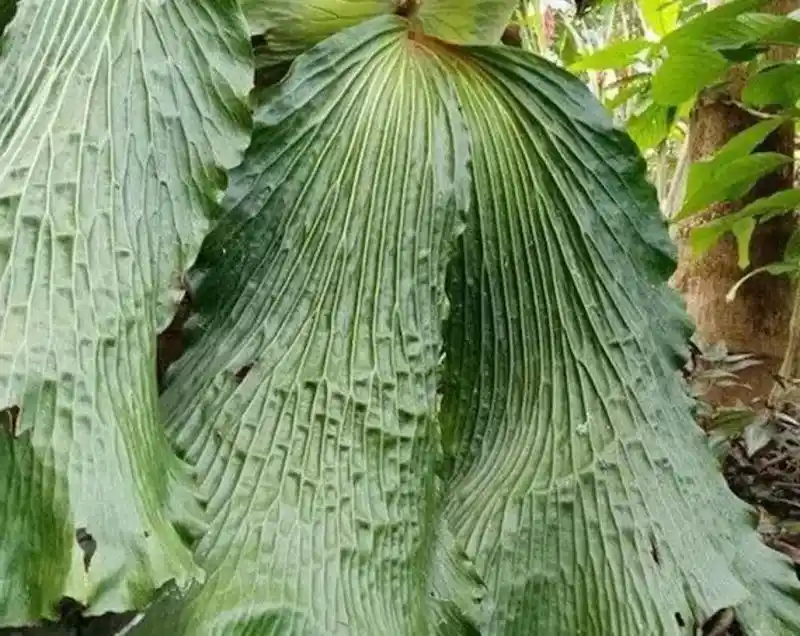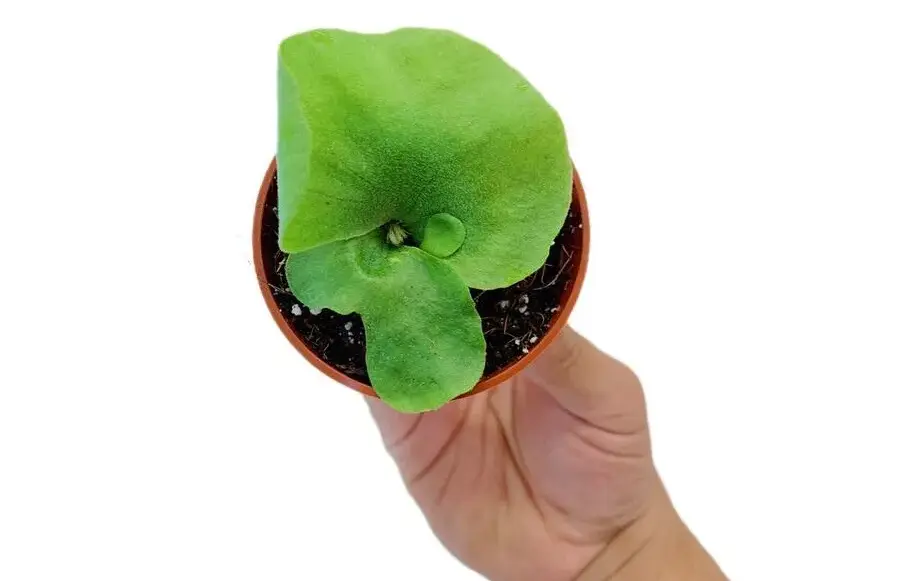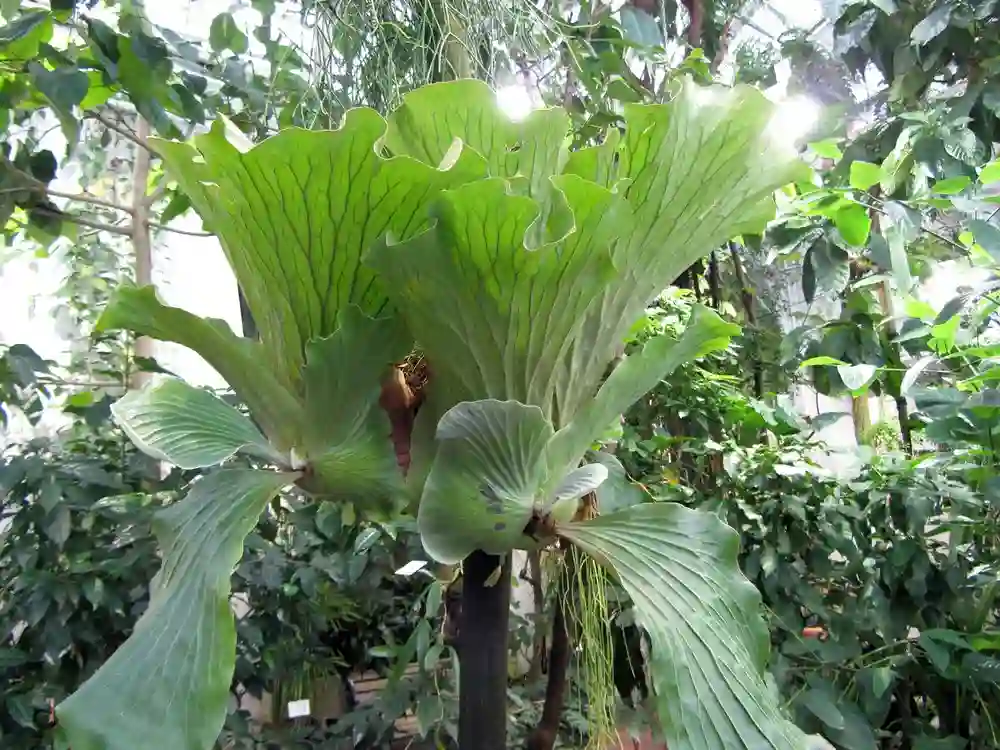Platycerium elephantotis, also known as the Elephant Staghorn fern, is an exotic and unique plant that is highly sought after by indoor plant enthusiasts and professional gardeners alike. This unusual fern is native to tropical regions of Africa and is part of the Polypodiaceae family.
Platycerium elephantotis is called the staghorn fern because its foliage resembles the antlers of a male deer or stag. It’s an epiphytic plant, meaning it anchors itself to trees and rocks using modified stems called rhizomes rather than rooting in soil. The staghorn fern is favored for its low maintenance needs, exotic appearance, and the fact that it can lend a tropical feel to any indoor space.
In its natural habitat, the staghorn fern can grow quite large, with fronds extending up to 3 feet long and 4 feet wide. With the right care and environment, even indoor specimens can reach impressive proportions. This beginner’s guide covers everything you need to know about successfully growing Platycerium elephantotis so you can enjoy this fascinating plant in your own home.
Platycerium elephantotis Plant Characteristics
Platycerium elephantotis has two distinct types of fronds that give rise to its common name. The basal “sterile” fronds are broad, flattened, and shield-shaped. They emerge in a rosette pattern from the rhizome attachment point. Mature sterile fronds are a blue-grey-green color and can grow 18-24 inches long. Their main function is to protect the plant’s root system.
The upper “fertile” fronds have an entirely different look, with narrow, dramatically arched branches that can extend 24-30 inches long. Fertile fronds are a tan or bronze shade and take on the antler-shape that gives rise to the staghorn moniker. On the undersides of fertile fronds are patches called sporangia where the plant produces spores.
As a tropical epiphyte, Platycerium elephantotis’s rhizomes have a crucial function. They anchor the plant to a substrate while absorbing water and nutrients from the air and any debris that collects around the base. The rhizomes look like thick brown roots or wires fuseing together the bases of all the fronds.

Platycerium elephantotis Natural Habitat
In nature, Platycerium elephantotis is native to tropical regions of central, eastern, and southern Africa. Here it grows in humid, warm rainforests, where it anchors itself high up on the branches of tall trees. The plant is also found growing on cliff faces, mossy boulders, and the stumps of dead trees.
Platycerium elephantotis thrives in dappled sunlight and shady conditions. It prefers humidity levels above 50%, warm temperatures in the 60-80 degree F range, and frequent rainfall. The plant is accustomed to having its roots surrounded by a layer of decomposing leaf litter and organic debris that accumulates in the crooks of tree branches.
These natural habitat preferences explain why certain conditions are required to keep a staghorn fern happy when grown indoors. Replicating its tropical, tree-dwelling environment is the key.
How to Grow Platycerium elephantotis Indoors
While it can be challenging for beginners to grow some types of tropical ferns as houseplants, the staghorn fern is relatively easy to care for. Follow these tips and you’ll have a happy, healthy specimen:
Lighting: Bright, filtered light is essential. Place your staghorn fern near an east or west-facing window where it will receive several hours of gentle, indirect sun each day. Direct hot sun will scorch the foliage. Insufficient light leads to small, slow growth.
Temperature: Room temperatures between 60-80 degrees F suit the staghorn fern best. Keep away from cold drafts, air vents, or excessive heat.
Humidity: High humidity is a must, ideally around 60-70%. Group plants together, use a humidifier, place on a pebble tray, or mist the fronds frequently to replenish moisture in the air.
Air Circulation: Gentle air flow prevents problems with pests and diseases. Use an oscillating fan to circulate the air around your staghorn ferns.
Water: Allow the plant to dry out slightly between waterings but don’t let it get bone dry. Water about once a week, aiming to keep the roots moist but not soggy wet. The rhizome, fronds, and substrate should never be soggy or waterlogged.
Fertilizer: Use a diluted houseplant fertilizer monthly in the growing season. Look for orchid fertilizers, as they are specially formulated for epiphytes.
Support: Staghorn ferns grow best when mounted on vertical substrates rather than planted in soil. Affix to tree fern plaques, cork boards, aged tree branches, slabs of tree fern fiber, or orchid mounts. Use fishing line or orchid wire to secure.
Substrate: Cover mounts with sphagnum moss to retain moisture and allow the rhizomes to attach. As an alternative, plant in an orchid mix or peaty potting soil in a basket or pot with excellent drainage.
Repotting: Repot every 2-3 years as needed to provide additional room for the rhizomes and roots to expand. Divide congested plants.
How to Display Platycerium elephantotis
A staghorn fern makes a striking display mounted on a wall or suspended from the ceiling of a conservatory or large plant room. Use strong hardware and fishing line or wire to affix to the mount. Site where it will receive bright, indirect light.
For tabletop or floor displays, place smaller specimens in baskets or on tree fern plaques or branches. The unique antler shape of the foliage looks incredible when allowed to cascade over the sides. Site near other tropical orchids and bromeliads to play up the theme.
Outdoors, a staghorn fern can be affixed to the trunks or lower branches of trees. Avoid direct hot sun by situating on the east or west side. Bring plants indoors before temperatures drop below 50 degrees F.

How to Propagate Platycerium elephantotis
Staghorn ferns are typically propagated by division when overcrowded or by spores for commercial growers and specialists. Here’s an overview of each process:
Division: Carefully divide congested plants by cutting apart the rhizomes so each section has roots and several fronds attached. Replant divisions individually in small mounts or baskets.
Spores: Spores form on the undersides of mature, fertile fronds. Collect ripe spores and sprinkle over sterile seedling mix. Cover and maintain high humidity. Tiny ferns will emerge in a few months. Transplant juveniles individually once they form fronds.
Propagation by division is quicker and easier for home growers. Producing staghorn ferns from spores has a lower success rate and requires expertise.
Common Problems with Platycerium elephantotis
When grown in suitable conditions, the staghorn fern is relatively pest and disease resistant. However, here are some potential problems to watch for:
- Foliage browning/yellowing – Excessive light, insufficient humidity, or underwatering.
- Slow growth – Insufficient light or nutrients.
- Rotting – Overwatering or overly wet substrate. Improve drainage.
- Mealybugs or scale – Treat with horticultural oil or insecticidal soap spray. Remove severely infested fronds.
- Fading fronds – Natural process as older fronds die off. Remove any that appear unhealthy.
Tips for Healthy Platycerium elephantotis Plants
Follow these tips and you’ll be rewarded with a thriving staghorn fern specimen:
- Acclimate new plants slowly to your indoor growing conditions.
- Grow in bright, filtered light for best results.
- Water thoroughly when partly dry then allow excess to drain fully.
- Mist frequently and group with other plants to increase humidity.
- Ensure excellent air circulation to prevent disease issues.
- Anchor securely to a suitable mount to support the plant as it matures.
- Feed monthly with diluted fertilizer during the growing season.
- Repot when rootbound into slightly larger mounts every 2-3 years.
- Propagate mature specimens to produce new plants for displaying.
Platycerium elephantotis Varieties
There are a few different varieties of Platycerium elephantotis to look for:
- Platycerium elephantotis cv. Willinckii – Features taller, more upright fronds.
- Platycerium elephantotis cv. Zieckianum – Very large sterile fronds extend 5 feet long.
- Platycerium elephantotis cv. Tabulare – Sterile fronds remain more compact and flattened.
When sourcing plants, look for those with healthy rhizomes and no signs of damage, rot, or pests. The colorful tan fertile fronds will be emerging from the blue-green sterile rosette.
Displaying Platycerium elephantotis in the Home or Garden
The uniquely antler-shaped foliage of the staghorn fern makes it an incredibly decorative houseplant or garden specimen. Here are some tips for putting those gorgeous fronds on display:
- Suspend smaller specimens in macrame or wire hangers.
- Affix to weather-resistant mounting panels or plaques on shaded patios or garden rooms.
- Place in front of bright windows where the silhouette of the fronds will be beautifully backlit.
- Use as a living work of art by mounting on walls in modern indoor spaces.
- Incorporate into relaxing bathrooms for an exotic spa-like atmosphere.
- Allow floor-standing plants to cascade over pedestal plant stands or plant shelves.
- Add fairy lights or grow lights to spotlight plants grown in darker indoor rooms.
The Benefits of Growing Platycerium elephantotis
Beyond being visually striking, there are many benefits to growing the staghorn fern in your living space:
Air Purification – All plants help filter indoor air, and the large fronds of Platycerium elephantotis help remove more pollutants.
Increased Humidity – The high moisture requirements of this tropical fern help humidify the surrounding environment.
Low Maintenance – Easy care needs make it ideal for beginners or busy plant parents.
Conversation Starter – The unique shape and size are sure to draw attention and comments.
Tropical Vibe – Lush staghorn ferns add an exotic, tropical look to indoor rooms.
Adaptability – Thrives equally well mounted or planted in soil if correctly cared for.
Versatile – Can be displayed in almost any spot from ceilings to shelves to wall mounts.
Stress Relief – Caring for plants reduces anxiety and is relaxing and rewarding.
Finding Platycerium elephantotis For Sale
Although not the most common houseplant, Platycerium elephantotis is gaining popularity and becoming easier to find at specialty plant stores or online:
- Check with local independent garden centers that carry tropical and orchid plants. Many can special order specimens.
- Search major retailers like Costa Farms, Glasshouse Works, and forwardgro.com that ship live staghorn ferns nationwide.
- Connect with orchid nurseries or houseplant shops online that have mail order sales and shipping.
- Join plant swapping groups on social media where people exchange cuttings and divisions of rare tropicals like this one.
- Check for local orchid society sales or shows where vendors offer more unique orchids and ferns.
- Search on sites like Etsy or eBay where independent growers sell plants and may have hard-to-find varieties for sale.
When buying Platycerium elephantotis, select plants with healthy rhizomes and no signs of pests, disease, or damage. Look for new fertile fronds emerging among the gray-green sterile foliage. With proper care, even small starter plants will flourish into impressive specimens for your home in no time.
Final Thoughts on Growing Platycerium elephantotis
The staghorn fern is sure to be a showstopper in any indoor plant collection or tropical garden. Caring for Platycerium elephantotis is very manageable for most growers once you recreate its warm, humid, forest-like habitat. Provide bright filtered light, abundant moisture, excellent air flow, and room to grow.
Mounted on a plaque or basket and misted frequently, the staghorn fern’s cascades of uniquely shaped fronds will provide years of exotic jungle vibes. This ancient fern still thrives today much as it did millions of years ago in the steamy rainforests of Africa where it originated. Certainly a plant worth adding to your indoor oasis!













Comments are closed.